Characterization of Mechanical Heterogeneity in Dissimilar Metal Welded Joints
Abstract
:1. Introduction
2. Materials and Methods
2.1. UMAT Theoretical Basis
2.2. Material Model
2.3. Geometric Model
2.4. Mesh and Load Model
3. Results and Discussion
3.1. Continuous Transition Model Simulation Results
3.2. Local Stress–Strain Simulation Results at the SA508/52Mb and 52Mw/316L Interfaces
3.3. Effect of Mechanical Heterogeneity on the DMWJ Local Region Mechanical Properties
4. Conclusions
- (1)
- The use of a user-defined material utility, UMAT, enables the continuous variation of mechanical properties in all regions of the DMWJ to be characterized to obtain more accurate and realistic results.
- (2)
- By considering the local mechanical heterogeneity, the proposed method avoids mismatching interregional material and geometric properties and eliminates abrupt changes in interfacial stresses. Accurate finite element simulations were performed using ABAQUS commercial software.
- (3)
- Owing to their serious mechanical heterogeneities, particularly in the interface regions, the local mechanical properties of DMWJs change considerably. Compared with the 52Mw/316L interface region, the SA508/52Mb interface region is more susceptible to mechanical heterogeneity and should be regarded as a high-risk region in terms of structural integrity.
Author Contributions
Funding
Institutional Review Board Statement
Informed Consent Statement
Data Availability Statement
Conflicts of Interest
References
- Andresen, P.L. A brief history of environmental cracking in hot water. Corrosion 2019, 75, 240–253. [Google Scholar] [CrossRef]
- Chopra, O.K.; Chung, H.M.; Kassner, T.F.; Park, J.H.; Shack, W.J.; Zhang, J.; Brust, F.W.; Dong, P. Current research on environmentally assisted cracking in light water reactor environments. Nucl. Eng. Des. 1999, 194, 205–223. [Google Scholar] [CrossRef]
- Ming, H.L.; Zhu, R.L.; Zhang, Z.M.; Wang, J.Q.; Han, E.H.; Ke, W.; Su, M.X. Microstructure local mechanical properties and stress corrosion cracking susceptibility of an SA508-52M-316LN safe-end dissimilar metal weld joint by GTAW. Mater. Sci. Eng. 2016, 669, 279–290. [Google Scholar] [CrossRef]
- Chhibber, R.; Arora, N.; Gupta, S.R.; Dutta, B.K. Use of bimetallic welds in nuclear reactors: Associated problems and structural integrity assessment issues. Proc. Inst. Mech. Eng. Part C J. Mech. Eng. Sci. 2006, 220, 1121–1133. [Google Scholar] [CrossRef]
- Lim, Y.S.; Kim, D.J.; Kim, S.W.; Kim, H.P. Crack growth and cracking behavior of Alloy 600/182 and Alloy 690/152 welds in simulated PWR primary water. Nucl. Eng.Technol. 2019, 51, 228–237. [Google Scholar] [CrossRef]
- Dong, L.J.; Ma, C.; Peng, Q.J.; Han, E.H.; Ke, W. Microstructure and stress corrosion cracking of a SA508-309L/308L-316L dissimilar metal weld joint in primary pressurized water reactor environment. J. Mater. Sci. Technol. 2020, 40, 1–14. [Google Scholar] [CrossRef]
- Wang, H.T.; Wang, G.Z.; Xuan, F.Z.; Liu, C.J.; Tu, S.T. Local mechanical properties of a dissimilar metal welded joint in nuclear power systems. Mater. Sci. Eng. 2013, 568, 108–117. [Google Scholar] [CrossRef]
- Fan, K.; Wang, G.Z.; Tu, S.T.; Xuan, F.Z. Effects of toughness mismatch on failure behavior of Bi-material interfaces. Procedia Eng. 2015, 130, 754–762. [Google Scholar] [CrossRef] [Green Version]
- Fan, K.; Wang, G.Z.; Xuan, F.Z.; Tu, S.T. Effects of work hardening mismatch on fracture resistance behavior of bi-material interface regions. Mater. Des. 2015, 68, 186–194. [Google Scholar] [CrossRef]
- Xue, H.; Ogawa, K.; Shoji, T. Effect of welded mechanical heterogeneity on local stress and strain ahead of stationary and growing crack tips. Nucl. Eng. Des. 2008, 239, 628–640. [Google Scholar] [CrossRef]
- Fan, K.; Wang, G.Z.; Yang, J.; Xuan, F.Z.; Tu, S.T. Numerical analysis of constraint and strength mismatch effects on local fracture resistance of bimetallic joints. Appl. Mech. Mater. Trans. Technol. 2015, 750, 24–31. [Google Scholar] [CrossRef]
- Dong, L.; Peng, Q.; Han, E.-H.; Ke, W.; Wang, L. Microstructure and intergranular stress corrosion cracking susceptibility of a SA508-52M-316L dissimilar metal weld joint in primary water a dissimilar metal welded joint in nuclear power plants. Nucl. Eng. Des. 2013, 265, 145–153. [Google Scholar] [CrossRef]
- Gan, J.L.; Peng, Y.; Dong, J. The Effect of the Heterogeneous Pattern of Material Mechanical Properties on the Structural Performance Analysis of Butt Joints. Prog. Steel Build. Struct. 2017, 19, 41–46. [Google Scholar] [CrossRef]
- Altenbach, H.; Altenbach, J.; Kissing, W. Mechanics of Composite Structural Elements, 2nd ed.; Springer: Singapore, 2018; pp. 503–504. [Google Scholar]
- Burlayenko, V.N.; Sadowski, T.; Dimitrova, S. Three-dimensional free vibration analysis of thermally loaded FGM sandwich plates. Materials 2019, 12, 2377. [Google Scholar] [CrossRef] [Green Version]
- Lu, C.; Zhao, M.; Jie, L.; Wang, J.; Gao, Y.; Cui, X.; Chen, P. Stress distribution on composite honeycomb sandwich structure suffered from bending load. Procedia Eng. 2015, 99, 405–412. [Google Scholar] [CrossRef] [Green Version]
- Szekrényes, A. Analytical solution of some delamination scenarios in thick structural sandwich plates. J. Sandw. Struct. Mater. 2019, 21, 1271–1315. [Google Scholar] [CrossRef] [Green Version]
- Geng, S.N.; Sun, J.S.; Guo, L.Y.; Wang, H.Q. Evolution of microstructure and corrosion behavior in 2205 duplex stainless steel GTA-welding joint. J. Manuf. Process. 2015, 19, 32–37. [Google Scholar] [CrossRef]
- Xue, H.; Bi, Y.Q.; Wang, S.; Zhang, J.L.; Gou, S.Y. Compilation and Application of UMAT for Mechanical Properties of Heterogeneous Metal Welded Joints in Nuclear Power Materials. Adv. Mater. Sci. Eng. 2019. [Google Scholar] [CrossRef] [Green Version]
- Guo, R.; Xue, H.; Gong, X.Y. Influence of residual stress and heterogeneity on mechanical field at crack tips in safety end of nuclear power plant. Procedia Struct. Integr. 2018, 13, 2202–2209. [Google Scholar] [CrossRef]
- Zhao, L.Y.; Xue, H.; Jiao, K.; Tang, W. Stress Corrosion Cracking Behavior of an Alloy 182-A533B Weld Joint with Continuous Material Properties. Adv. Mater. Res. 2013, 716, 355–359. [Google Scholar] [CrossRef]
- Lu, D.C.; Du, X.L.; Wang, G.S.; Zhou, A.N.; Li, A.K. A three-dimensional elastoplastic constitutive model for concrete. Comput. Struct. 2016, 163, 41–55. [Google Scholar] [CrossRef]
- Yang, S.Y. Conversion of ABAQUS user material subroutines. J. Comput. Struct. Eng. Inst. Korea 2010, 23, 635–640. [Google Scholar]
- Kim, J.; Kim, D.N. Robust stress integration algorithms for implicit elastoviscoplastic finite element analysis of materials with yield-point phenomenon. Int. J. Mech. Sci. 2019, 150, 277–289. [Google Scholar] [CrossRef]
- Liao, D.; Yang, Z.X.; Xu, T.T. J2-deformation-type soil model coupled with state-dependent dilatancy and fabric evolution: Multiaxial formulation and FEM implementation. Comput. Geotech. 2021, 129, 103674. [Google Scholar] [CrossRef]
- Ming, H.L.; Zhang, Z.M.; Wang, J.Q.; Han, E.H.; Su, M.X. Microstructure and local properties of a domestic safe-end dissimilar metal weld joint by using hot-wire GTAW. Acta Metall. Sin. 2016, 53, 57–69. [Google Scholar] [CrossRef]
- Fan, K.; Wang, G.Z.; Xuan, F.Z.; Tu, S.T. Local fracture resistance behavior of interface regions in a dissimilar metal welded joint. Eng. Fract. Mech. 2015, 136, 279–291. [Google Scholar] [CrossRef]
- Peng, Y.; Wu, C.; Gan, J.L.; Dong, J. Characterization of heterogeneous constitutive relationship of the welded joint based on the stress-hardness relationship using micro-hardness tests. Constr. Build. Mater. 2019, 202, 37–45. [Google Scholar] [CrossRef]
- Liu, R.F.; Wang, J.C. Finite element analyses of the effect of weld overlay sizing on residual stresses of the dissimilar metal weld in PWRs. Nucl. Eng. Des. 2021, 372, 110959. [Google Scholar] [CrossRef]
- Fan, K.; Wang, G.Z.; Xuan, F.Z.; Tu, S.T. Local failure behavior of a dissimilar metal interface region with mechanical heterogeneity. Eng. Fail. Anal. 2016, 59, 419–433. [Google Scholar] [CrossRef]
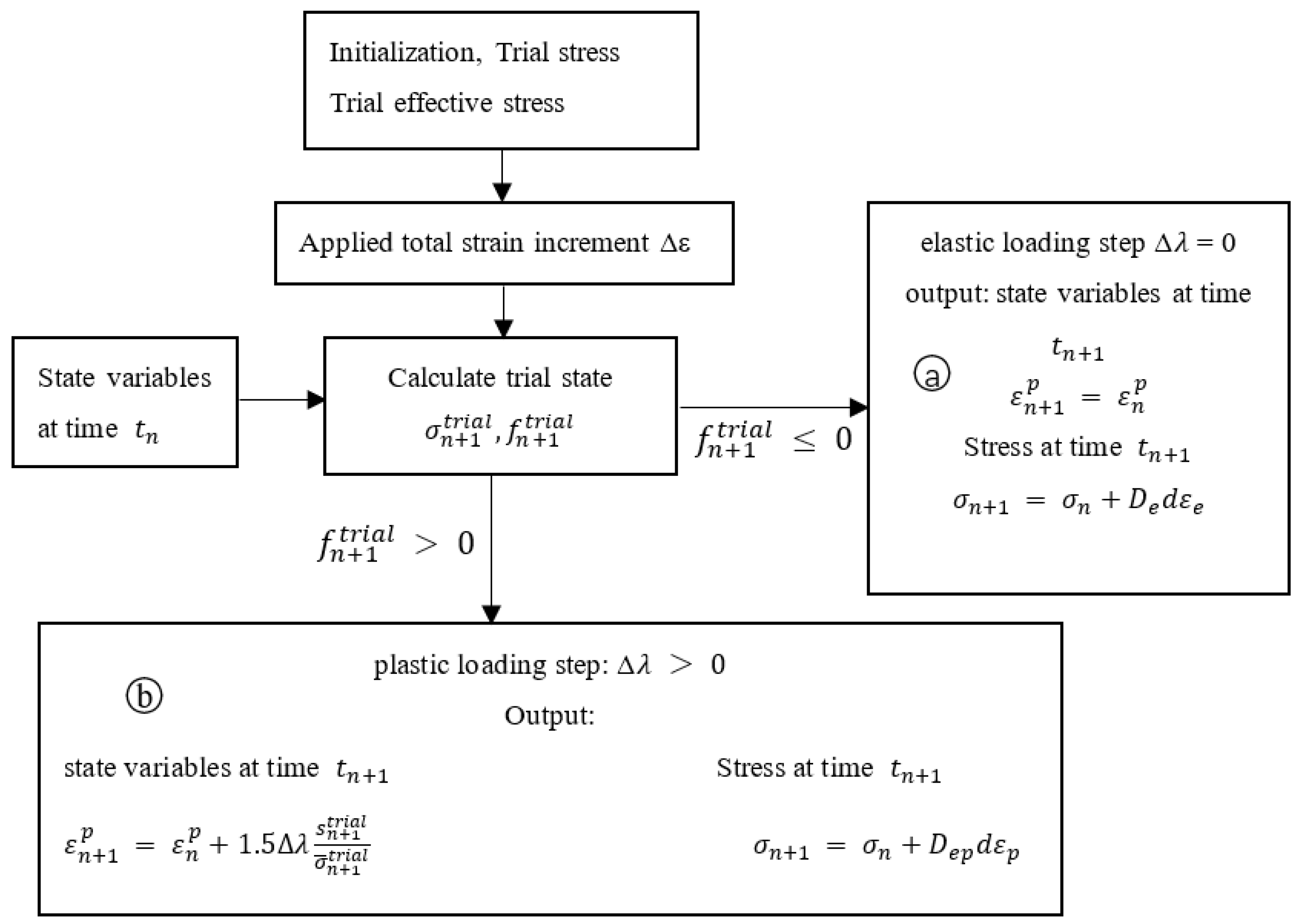

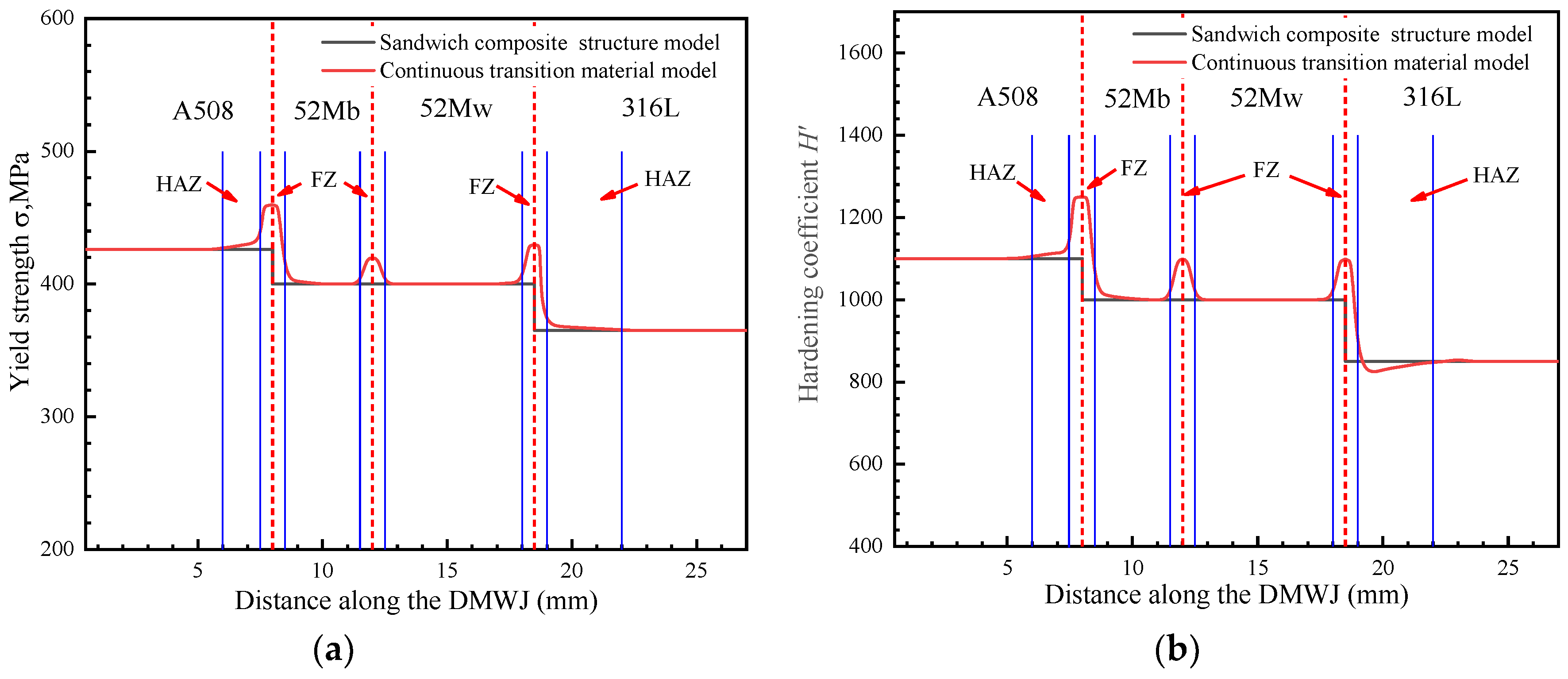
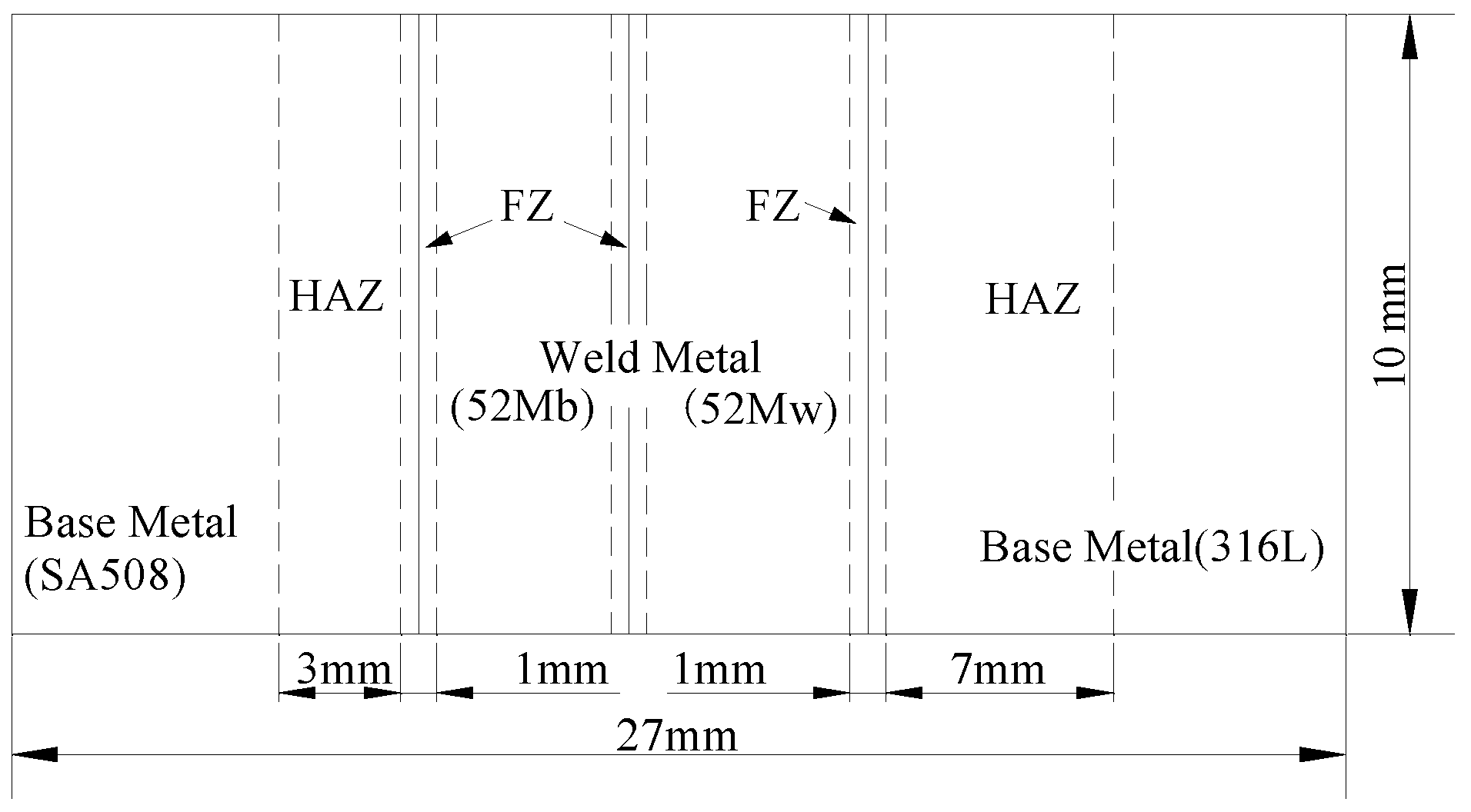

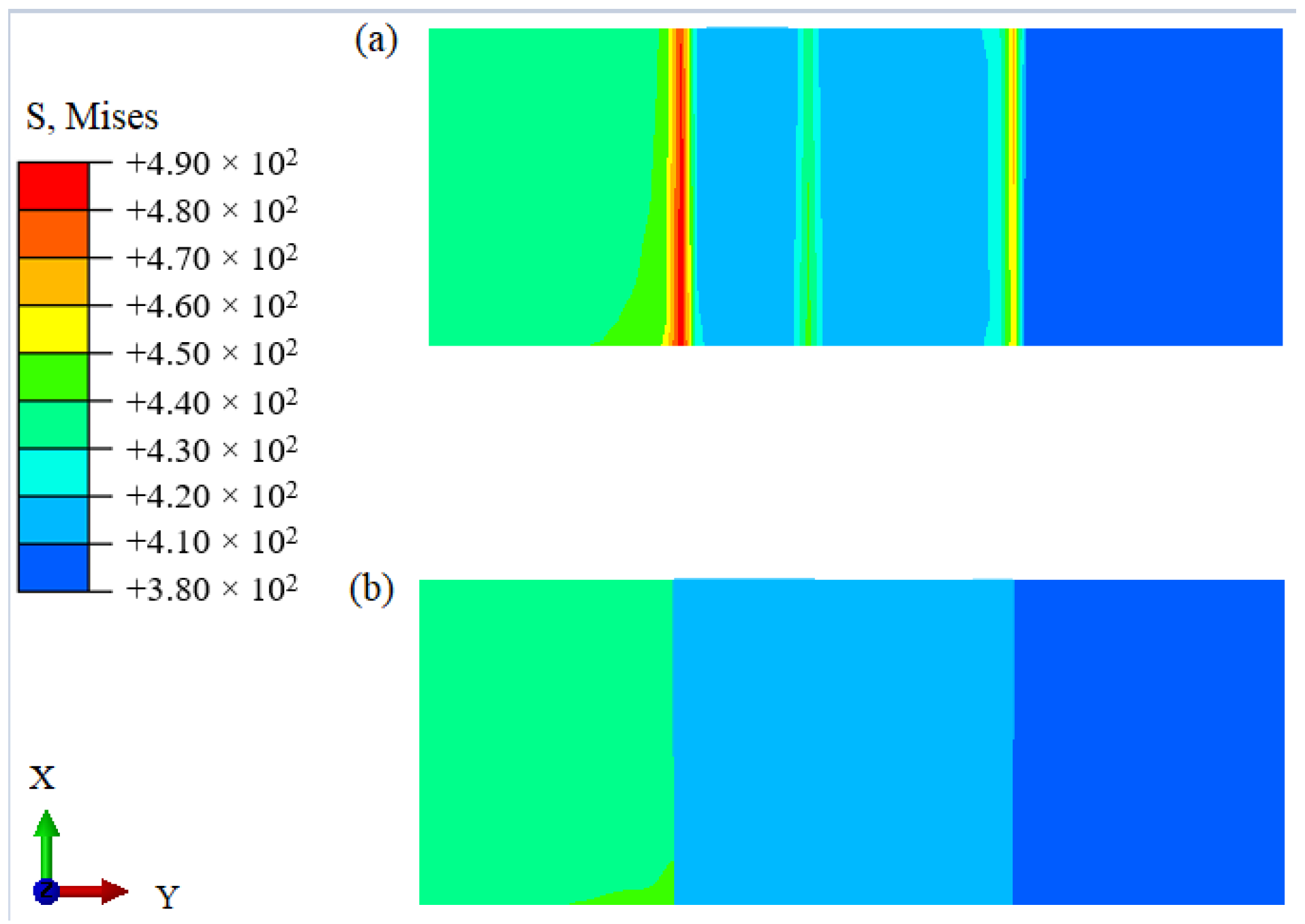
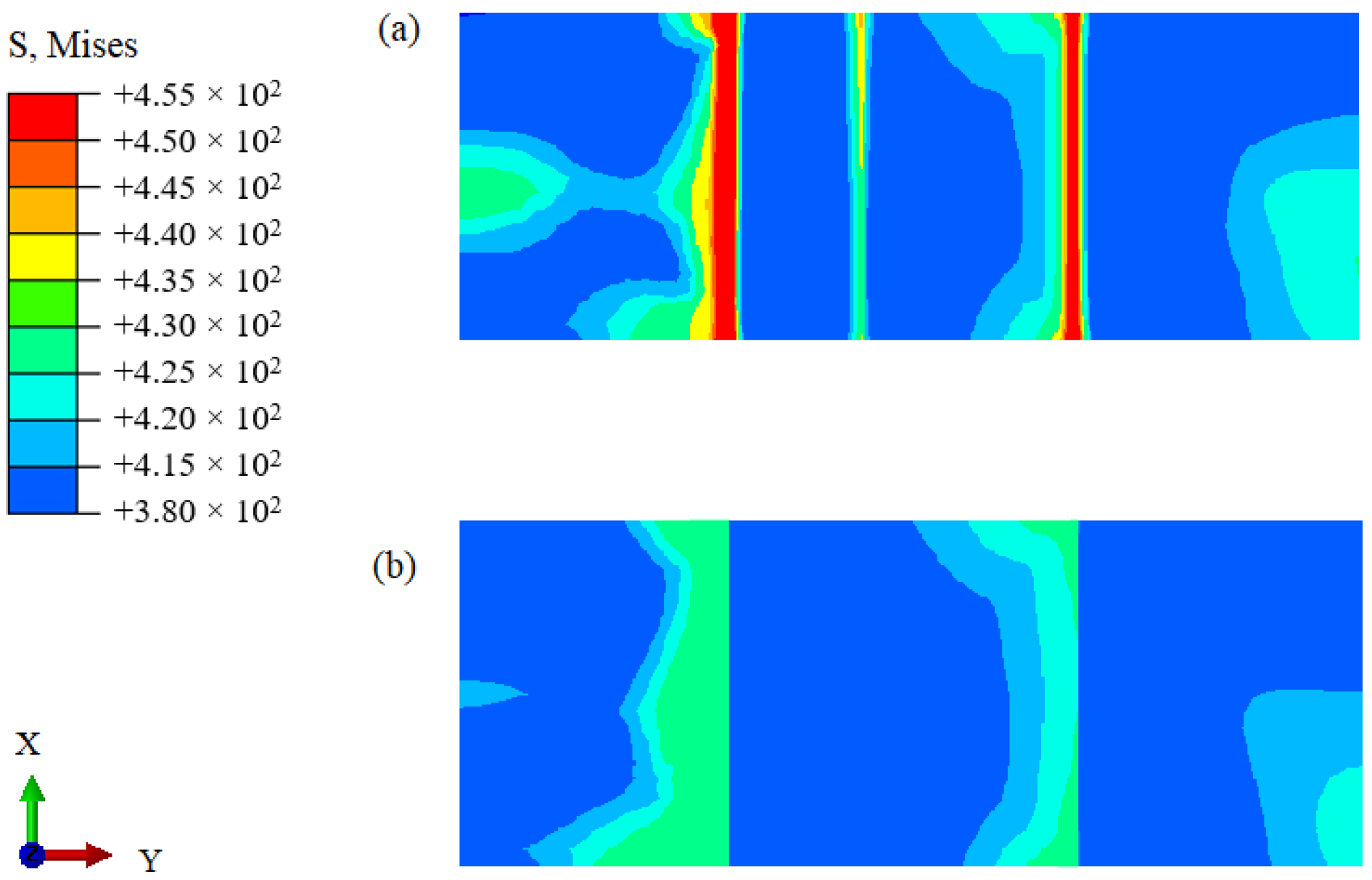
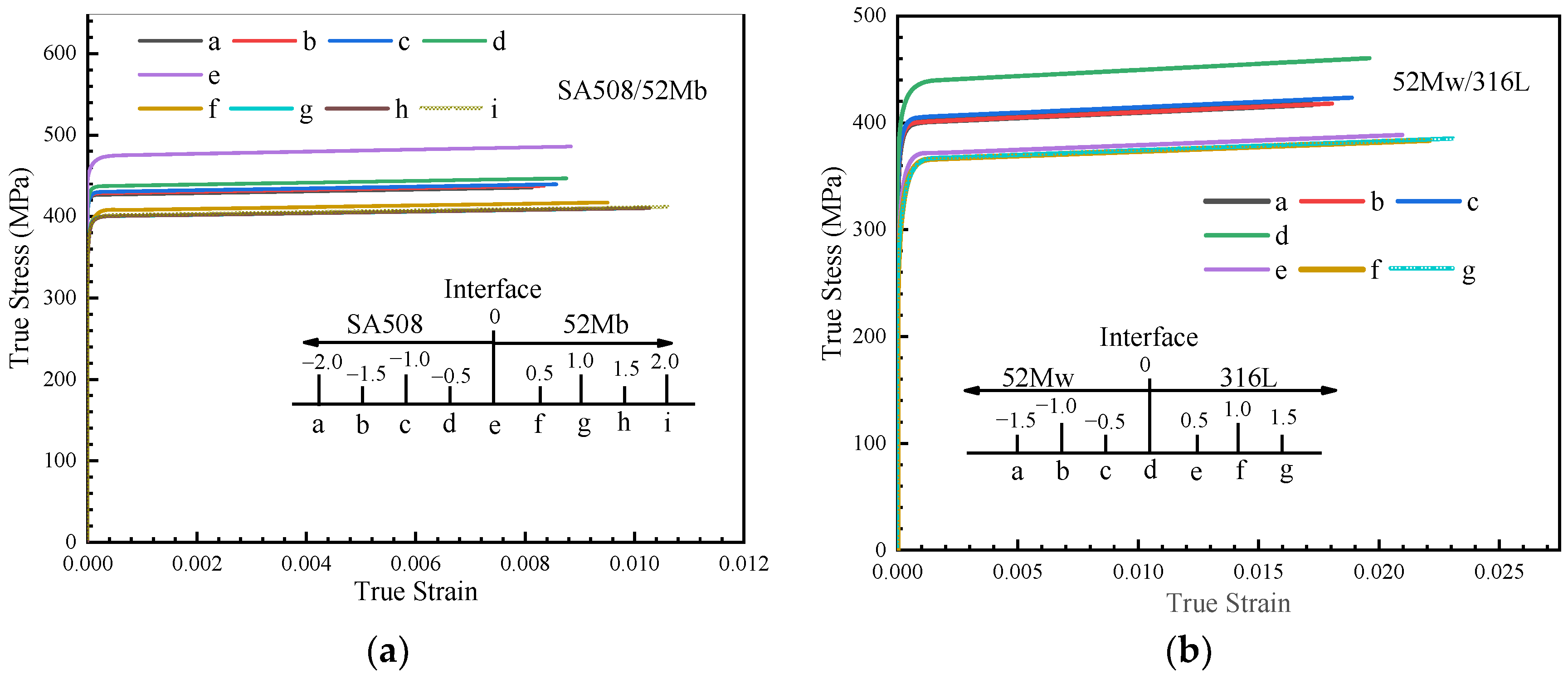


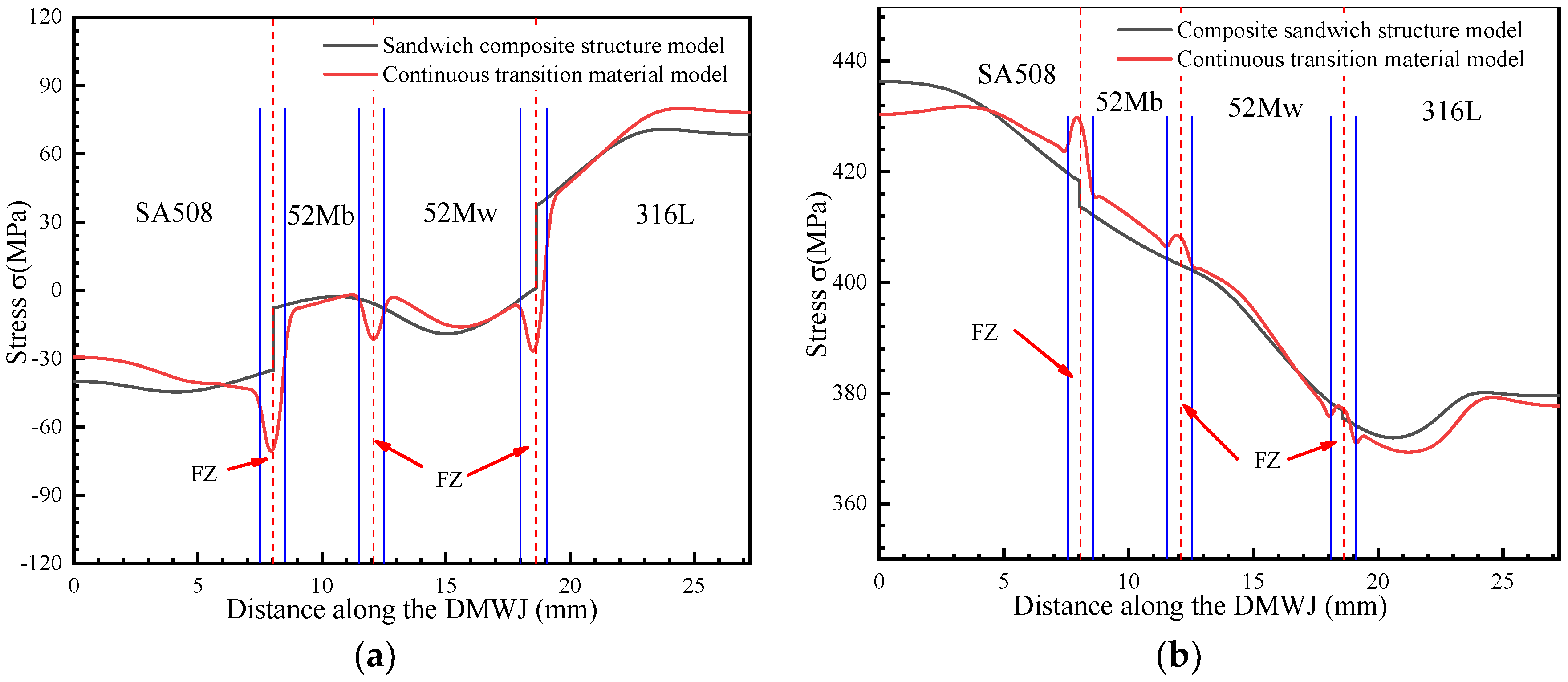

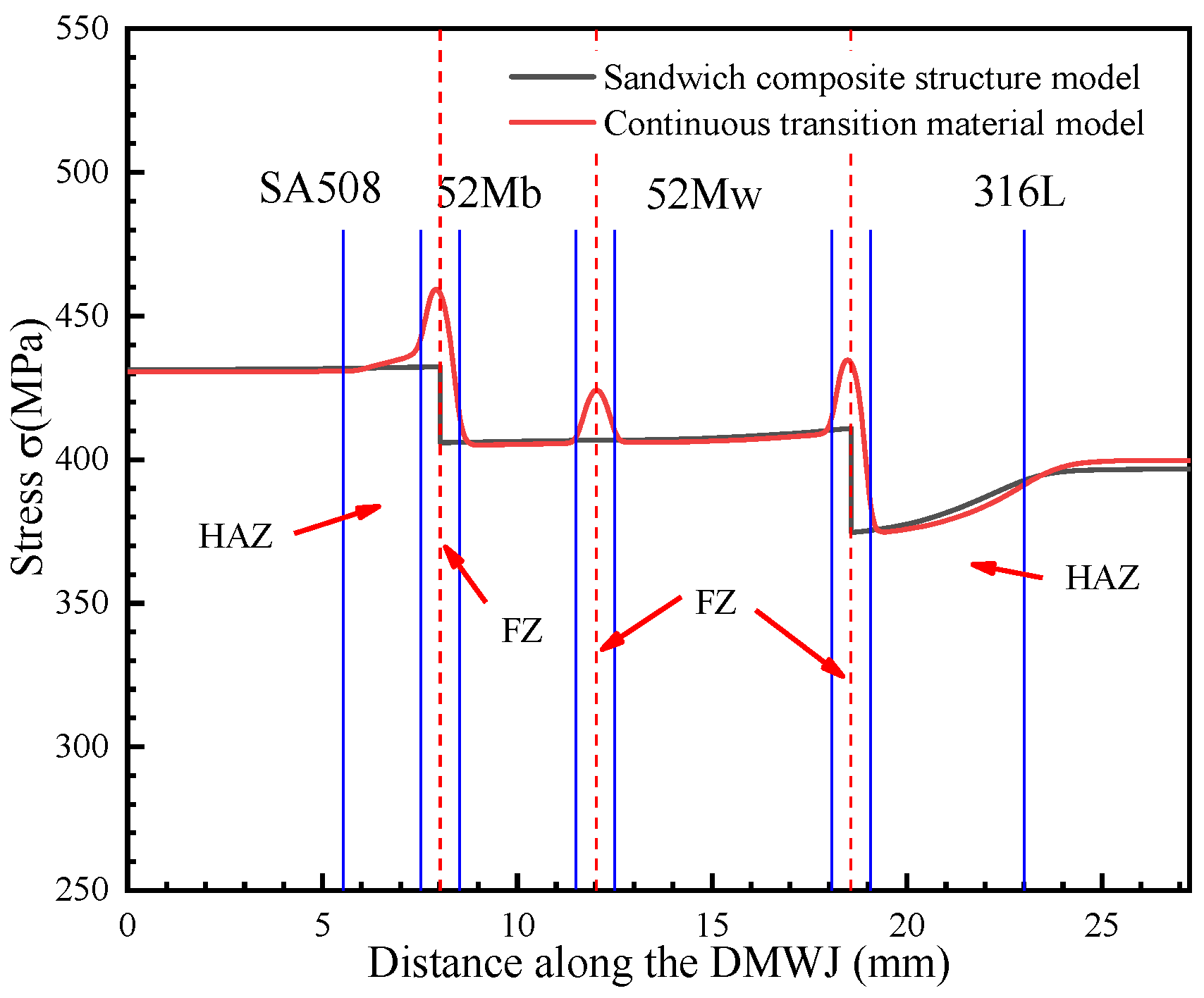

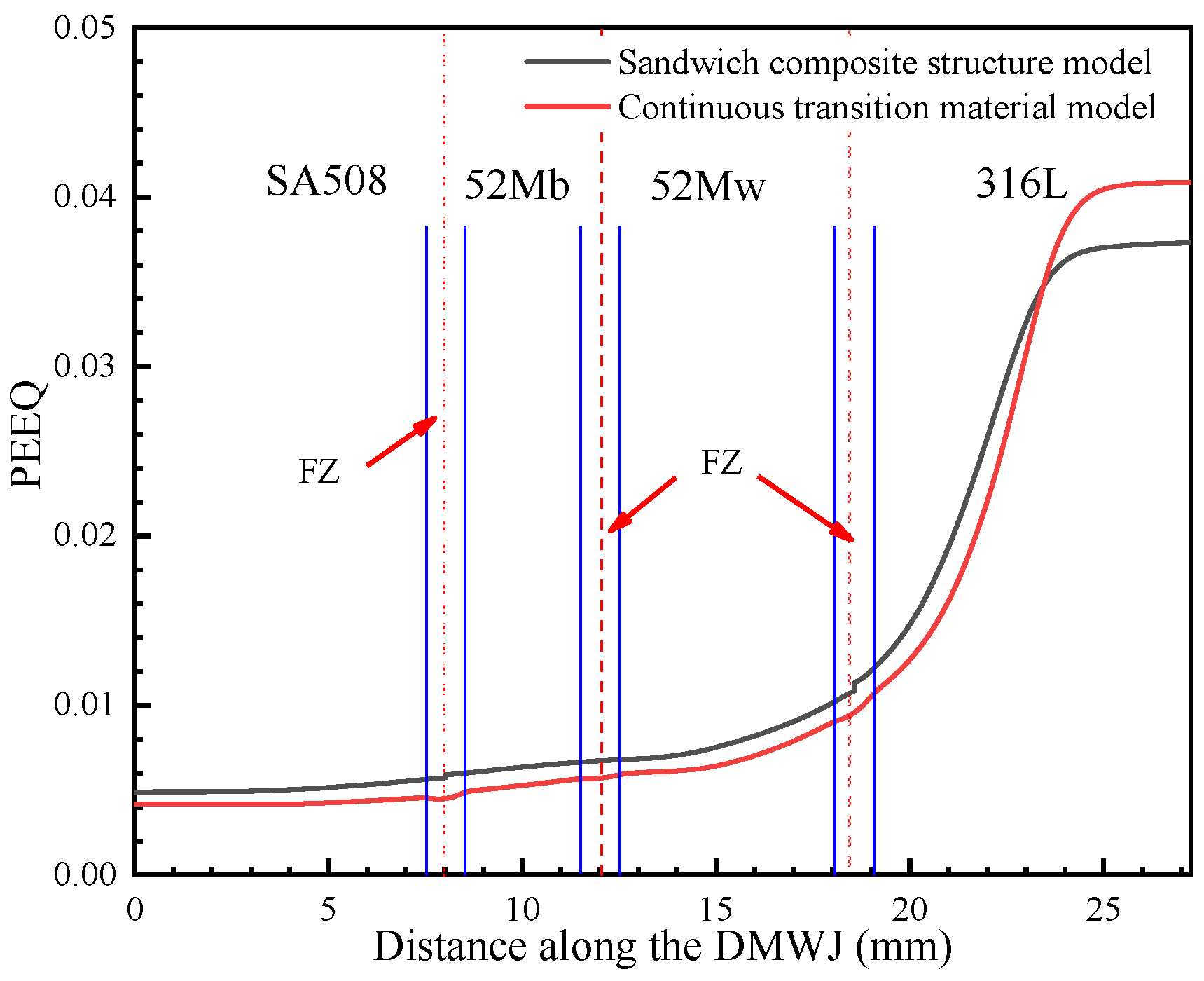
| Material | C | Si | Mn | Cr | S | Ni | Fe | P | Mo | N |
|---|---|---|---|---|---|---|---|---|---|---|
| SA508 | 0.170 | 0.210 | 1.360 | 0.16 | 0.001 | 0.80 | Bal. | 0.006 | 0.490 | - |
| 52Mb | 0.020 | 0.110 | 0.890 | 29.77 | <0.0005 | 59.20 | 8.73 | 0.003 | 0.008 | 0.006 |
| 52Mw | 0.023 | 0.110 | 0.900 | 29.77 | <0.0005 | 59.30 | 8.74 | 0.003 | 0.100 | 0.006 |
| 316L | 0.014 | 0.624 | 1.576 | 17.34 | <0.001 | 10.84 | Bal. | 0.026 | 2.210 | 0.116 |
Publisher’s Note: MDPI stays neutral with regard to jurisdictional claims in published maps and institutional affiliations. |
© 2021 by the authors. Licensee MDPI, Basel, Switzerland. This article is an open access article distributed under the terms and conditions of the Creative Commons Attribution (CC BY) license (https://creativecommons.org/licenses/by/4.0/).
Share and Cite
Xue, H.; Wang, Z.; Wang, S.; He, J.; Yang, H. Characterization of Mechanical Heterogeneity in Dissimilar Metal Welded Joints. Materials 2021, 14, 4145. https://doi.org/10.3390/ma14154145
Xue H, Wang Z, Wang S, He J, Yang H. Characterization of Mechanical Heterogeneity in Dissimilar Metal Welded Joints. Materials. 2021; 14(15):4145. https://doi.org/10.3390/ma14154145
Chicago/Turabian StyleXue, He, Zheng Wang, Shuai Wang, Jinxuan He, and Hongliang Yang. 2021. "Characterization of Mechanical Heterogeneity in Dissimilar Metal Welded Joints" Materials 14, no. 15: 4145. https://doi.org/10.3390/ma14154145








